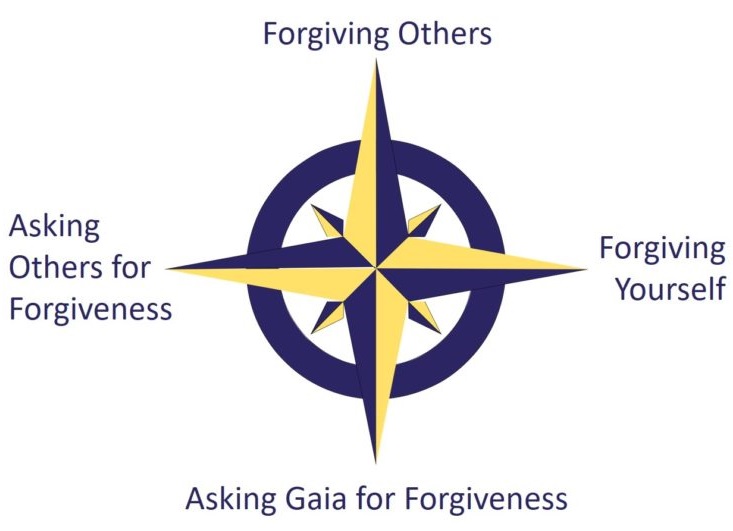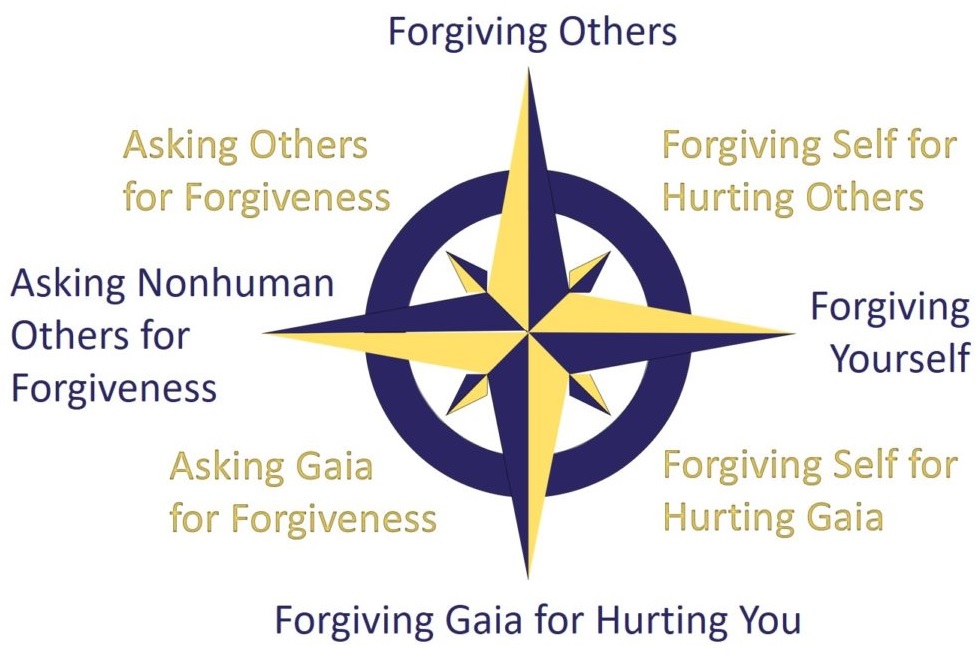In karate, in order to become skilled in both form and technique, we practice kata (formal exercises that combine attacks and blocks). Direction is an essential part of katas, symbolizing where your opponents are attacking from. Often, early belt katas follow the cardinal directions: north (meaning the direction you faced when starting the kata), south, east, and west. But as one gets more advanced, many katas orient on northeast, southeast, southwest, and northwest, like the green belt kata “Goho no uke shodan,” or five-direction block (with the fifth direction being north). Engaging in the ordinal directions, not just the cardinal directions, helps us stay more flexible in our orientation as well create a more complex art and symmetry in the design of those kata.
As I’ve incorporated forgiveness into my meditation practice, it feels as if forgiveness meditations can have directionality as well—both a basic white belt version and a more complex “green” belt version (sorry, couldn’t help the pun). Let’s start with the white belt version:
The Cardinal Directions of Forgiveness
Jack Kornfield, a Buddhist teacher, suggests that there are three key elements of a forgiveness meditation:
First, forgive others for hurting you. This is the starting point—the north for this meditation exercise. We all have painful memories and experiences of being hurt by others, which shape us, and perhaps continue to shape the pain we wield on others. Visualize the pain that you felt as someone hurt you. Observe that pain, let it go, and forgive that person. (Some pains, naturally, will be easier to let go of than others—so start with some easy ones, and as Kornfield explains, let go of the deeper wounds, “to the extent that [you] are ready.”)
Now, moving to the west, ask others to forgive you for hurting them. “Feel your own sorrow and regret,” Kornfield suggests. And as you think of someone you wronged, as you reflect on that experience, ask those you hurt for their forgiveness.
Then, to the East, forgive yourself. For the wrongs you inflicted harm on your self, “knowingly or unknowingly,” in thought, word, or deed. From “being weak” to continuing to make bad choices, to grappling with an explosive temper, whatever you’re stuck on, observe it, let it go, and forgive yourself.
The idea, with any forgiveness meditation, is to give yourself permission to let go of the pain, whether of wounds caused to you or wounds you’ve caused yourself or others as well as the regret that continues to make that wound tender. Now that’s not to say you can forgive yourself and then keep on hurting others (as with Christianity—it doesn’t count to get your sins absolved and then keep on sinning in the same way!). This meditation has to be done with sincerity to be the start of healing.
But there is a fourth essential element—a fourth direction—to this meditation that, from a Gaian perspective, Kornfield left out:

The white belt version of this meditation exercise: Shiho Yurushi
Facing the South: ask forgiveness of Gaia. We hurt the Earth regularly and should seek out forgiveness for the many wounds we cause, knowingly and unknowingly, willingly and unwillingly.
Now that all sounds simple enough. Try that as a meditation. And when doing so, I encourage you to physically reorient yourself as you transition your mind from one subject to the next. For example, get two sticks to make a simple compass and use that to move from north to west to east to south.* Take your time with each of these. If you have 20 minutes you can focus on each for 5 minutes, though if 20 minutes go by and you’re still forgiving others, that’s fine. This is a cumulative meditation—meaning each time you do it, the practice builds on itself. After forgiving that bully who stole your lunch one time in third grade, you probably won’t dwell on him any longer, freeing more time and space to advance through the practice.
The Ordinal Directions of Forgiveness
Now I want to add a-whole-nother layer of nuance to this: the ordinal directions, which I think are as, if not more potent, in flexing one’s forgiveness muscles.
Still start with the north, forgiving others. Then move to the northeast: In between forgiving oneself and forgiving others, is forgiving yourself for hurting others. This feels different than forgiving oneself for self-oriented pains. Instead, this is forgiveness focused on letting go of the suffering you’re causing yourself through hurting others in the past (whether long ago or as recently as yesterday). Some of those individuals, you may have lost touch with or they may have even returned to Gaia and can no longer forgive you, but you can always forgive yourself.
Move on to the east, to deepen self-forgiveness, then move onto the northwest: In this version, the northwest becomes the direction we ask other people for forgiveness (a complement to our northeast). To the west, we ask forgiveness of other non-human beings. This can include asking forgiveness of cows or chickens for eating their flesh to sustain your life or the squirrel you ran over on the way to work two summers ago or the moths you killed in your pantry last spring. Or the wildlife you killed through your use of electricity and fossil fuels (through habitat destruction, pollution, bird deaths, and so on). This one, unlike childhood transgressions, is one realm we will always have new wrongs to ask forgiveness for.
Now let’s grapple with the southwest, south and southeast together.
To the southwest, ask Gaia to forgive you (and others) for hurting Gi.** As with non-human others, our modern lives are causing irreparable harm to the living Earth. Some of this is in our control, much is not, but that doesn’t mean we’re not responsible—and that we shouldn’t try to reduce those impacts, or ask for forgiveness. Explore the harms you’re perpetuating, observe whether these are truly necessary or not, let go of the guilt and pain, ask for forgiveness of Gaia.
Now, to the southeast, forgive yourself for hurting Gaia—and for being embedded in a system in which no matter how ‘good’ you try to be, you’re going to be bad. Again, that is not a carte blanche to keep on consuming mindlessly, but being wracked in guilt for things out of your control is not healthy either. Forgive yourself, commit yourself to doing better, and let go of the pain.
And to the south—and this one may surprise you—forgive Gaia for the pain Gi has brought.
There have always been natural disasters—lightning strikes and storms, earthquakes and eruptions that hurt people as Gaia changes and evolves. Those we can and should forgive Gaia for. “Unnatural” disasters will also become more numerous in the years to come—both because of a changing climate and a larger human population (spreading out to and building over areas that used to be natural buffers that absorbed these disasters’ energy).

The green belt version of this forgiveness meditation: Hachiho Yurushi
Considering more and more of the disasters we encounter will be unnatural, it is hard to truly blame Gaia for these—it is we and others who are at fault (southwest). And yet, many of us will still be hurt and angry when these disasters happen. (And when we’re hurt and angry many of us often lash out inflicting pain on others.) Gaia is not at fault, but many will probably blame Gi anyway. For the fires, the floods, the droughts. And that’s dangerous as it’ll certainly lead to more alienation, more difficulty in our relationships with “nature,” and more efforts to control Gaia instead of treat Gi fairly. So that is our final direction, our South.
For many of us, Gaia has never caused us direct harm, thankfully, and we may think we can skip over this direction. But do this for others (both human and non-human beings) if you’d like, or proactively, because one day, you may end up being harmed by a natural or, more likely, unnatural disaster and be angry, even inconsolable. But having done this forgiveness meditation dozens, even hundreds of times before then, you will not let your pain poison your relationship with Gaia, enabling a more healing path forward.
All that might sound too complicated,*** so simply start with the cardinal directions. And as you get comfortable with that, try the green-belt version.
The Eight Directions of Forgiveness
Now, let’s bring this all together in what perhaps could be called Hachiho Yurushi (or Eight Directions of Forgiveness). I highly recommend trying this meditation exercise outside (as I recommend for all meditations). Take a few twigs to make a compass and physically rotate your body as you go through the meditation. I found moving was quite a helpful tool—mentally shifting from one body of forgiveness to the next. It was especially nice, as I was in a field with a beautiful background surrounding me in all directions. Three or four minutes a direction makes for a 24 or 32 minute meditation—with 8 natural adjustments making it easier to sustain (or 6 minutes for each direction in the cardinal version).
But you don’t have to move if that diminishes the experience. Nor do you have to move through the directions in the same order. Or do all the directions every time. Just pick one or two directions that you’re struggling with. Internal conflict, something you did to others? Or another did to you? And use this meditation to process that and let it go.
The practice has certainly helped me. It led me to forgive some early—and recent—hurts, be more compassionate and quicker to forgive, and most importantly, it led me to reach out to and reconnect with a dear friend who I thought I had hurt and who I missed deeply.
Good luck with the forgiveness kata, and if you try it, let me know how it goes!
Endnotes
* As with karate, north is a proxy for whichever direction you start in. Though if you know where north is, that’s great too!
** Gi is the pronoun for Gaia.
*** Notice that the easterly directions are all about forgiving oneself, the southerly directions are oriented on Gaia, and the westerly directions is about asking others for forgiveness. That may help in remembering the directions and orienting yourself.
|
ABOUT THE AUTHOR
Erik Assadourian has been a Senior Fellow at the Worldwatch Institute for 15 years and the Director of the Institute’s Transforming Cultures project since its creation in 2009 with production and publication of State of the World 2010: Transforming Cultures: From Consumerism to Sustainability. Erik is co-author of over a dozen books and an eco-educational board game, Catan: Oil Springs. He is a leading expert in sustainable development, economic degrowth, sustainable communities, consumerism, and cultural change. In his free time, Erik yardfarms and forages edibles where he lives. Erik recently obtained a certification on Sustainable Urban Agriculture from the University of District of Columbia. He is currently writing a book on Gaianism.
|